7 Best Leupold Binoculars of 2024 – Reviews & Top Picks
Last Updated on
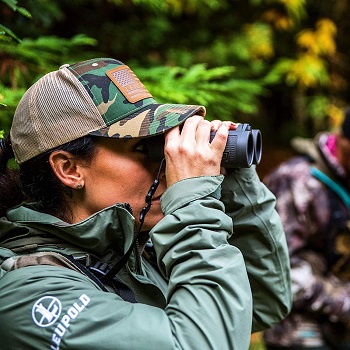
If you are looking for a great set of optics that you can use for hiking, bird watching, or even at the theatre, Leupold has a set that will work for you.
Not only do they provide clear and crisp pictures, but each one has its subtle differences. The only drawback to the equation is picking out which pair is going to suit your needs. As there are numerous ways a set of binoculars can be used, it can be difficult to figure out which ones are going to work best for you.
This is why we have found the top seven Leupold binoculars. We will review the lens, clarity, eye relief, and much more. If you need some additional help, we have provided a buyer’s guide, as well, to give you some extra info on each set.
A Quick Comparison of Our Favorites in 2024
| Image | Product | Details | ||
|---|---|---|---|---|
| Best Overall |
 |
Leupold BX-1 McKenzie Binocular |
|
CHECK PRICE |
| Best Value |
 |
Leupold BX-1 Rogue Compact Binoculars |
|
CHECK PRICE |
| Premium Choice |
 |
Leupold BX-4 Pro Guide HD Binocular |
|
CHECK PRICE |
 |
Leupold BX-2 Acadia Binocular |
|
CHECK PRICE | |
 |
Leupold BX-2 Alpine Binocular |
|
CHECK PRICE |
The 7 Best Leupold Binoculars
1. Leupold BX-1 McKenzie Binocular – Best Overall
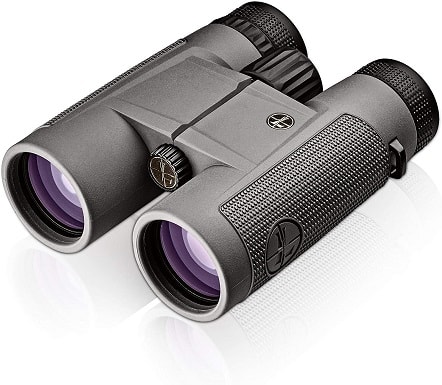
Our first option is the Leupold BX-1 Mckenzie Binoculars. This style comes in either a 10X42, 10X50, 12X50, 8X42 strength and range. These binoculars are great on the field as they are waterproof, fog-proof, and it has shock absorption. Not only that, but it has a multi-coated lens for a clear, crisp, and bright view.
The McKenzie uses 4 roof prisms to give you a perfectly round exit pupil, plus there is no edge distortion. What’s more, this set has an open bridge, easy to adjust center knob, plus they are lightweight.
These binoculars have a generous eye relief and extra max-light management to provide ten extra minutes of light. Not only are these great for the taking in the sites, but they can be used in low light occasions, as well. Overall, this is our top pick for a Leupold Binocular set.
- Water and fog-proof
- No edge distortion
- 10 additional minutes of light
- Multi-coated lens
- Crisp and clear image
- Eye relief
- None we can see
2. Leupold BX-1 Rogue Compact Binoculars – Best Value
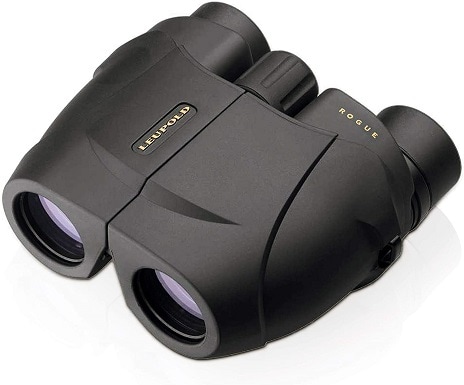
If you need a more affordable pair of binoculars, go with the Leupold BX-1 Rogue Compact Binoculars. This small set is great for hiking or to the theatre. It has an ergonomic design and a lightweight, durable frame.
This set comes in either a 10X25 or 8X25. It has inverted Porro prisms and creates clear, bright, and focused images. Not only that, but the lens is also waterproof. You can also make use of the multi-coated lens.
The Rogue set has no edge distortion to speak of, plus it has a generous eye relief. The only drawback of note is there is no fog-resistance to this set. Otherwise, this is the best Leupold Binoculars for the money.
- Multi-coated lens
- Inverted Porro prisms
- Waterproof
- Lightweight and ergonomic
- No edge distortion
- No fog-resistance
3. Leupold BX-4 Pro Guide HD Binocular – Premium Choice

If you are ready to spend the big bucks, the Leupold BX-4 Pro Guide HD Binocular could be a good option for you. This set is available in a 10X42 waterproof, shock-proof, and fog resistance option. They have a high definition calcium fluid lens that gives a great crisp picture that does not have any edge distortion.
The Guide features an open bridge and dual-hinge design. They have BAK4 prisms with a round exit pupil. You can also make use of the adjustable eyecups that provide a good amount of eye relief. What’s more, you have twilight max HD light management that will give you 30 minutes of additional see time in low light.
As mentioned above, one of the drawbacks to this model is they are more expensive, Beyond that, however, they are lightweight with an easy to hold handle. You also have a built-in tripod port for convenience.
- Water and fog-proof
- HD calcium fluid lens
- BAK4 prism
- Clear and bright picture
- No edge distortion
- Expensive
4. Leupold BX-2 Acadia Binocular

Our next pick is the Leupold BX-2 Acadia Binoculars. They are available in a 10X42 model that has a fully multi-coated lens to bring you bright and clear pictures of scenery, plus you can use them in low light events. This set is waterproof and fog-resistant, and you have a built-in tripod port.
The Acadia uses BAK4 prisms that do not let any distortion around the edges. They also have phase-coated roof prisms for sharp images. What’s more, there is plenty of eye relief with the twist eyecups. One thing to note, however, is this option does not have any shock-resistance, so going out on a wet day may not be the best option. Whatever you do, don’t drop the BX-2 Acadias.
Other than that, you can take advantage of the additional 10 minutes of light from the twilight max light management system. The only other drawback is this set is heavier to use, though it does have a convenient center twist knob, as well.
- Water and fog-resistance
- BAK4 prisms
- Clear and crisp
- 10 additional minutes of light
- Eye relief
- Heavy
- No shock absorption
5. Leupold BX-2 Alpine Binocular
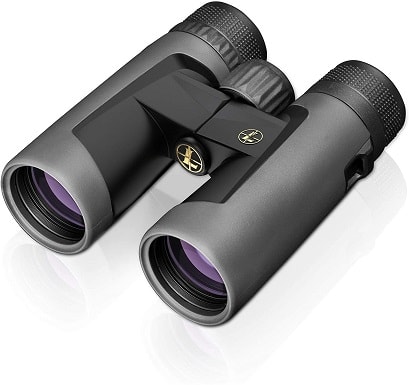
Our fifth option is the Leupold BX-2 Alpine Binocular set. You can choose from either a 10X42, 10X52, 12X52, or 8X42 style. They have both water and shock-resistance, yet they do not have any fog stopping ability.
The Alpine has a fully multi-coated lens for a bright and clear view of your surroundings. They have plenty of eye relief with the twist-up eyecups, plus there is a large central dial. One drawback you should be aware of, however, is the twilight max light management does not give you more than a few minutes of additional light.
You should also note that these binoculars are not as ergonomic as other options, and they can be a bit heavy. To end on a bright note, however, this set comes with a tripod port you can make use of when you need a steady picture.
- Fully multi-coated lens
- Clear and crisp
- Water and shock-resistance
- Eye relief
- Heavy
- Not as much additional light
- No fog-resistance
6. Leupold BX-1 Yosemite Binocular
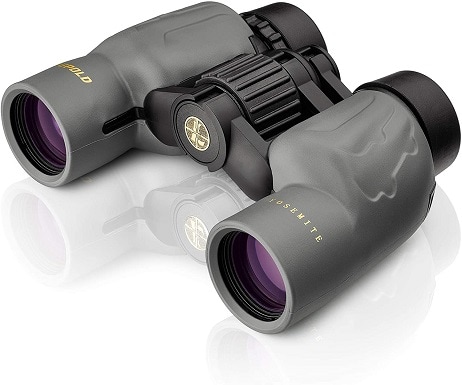
The Leupold BX-1 Yosemite Binocular set is a good option for using during hiking or bird watching. They have water, fog, and shock resistance, plus they have a fully multi-coated lens to provide you with a clear and crisp picture. One thing of note, however, is this set does not have as strong a resolution as others.
The Yosemite comes in either a 10X30, 6X30, or an 8X30 magnification. Please be advised that this set is not the best model to use for low light occasions such as the theatre or opera. Also, there is no tripod port available to keep the binocular set steady.
On the other hand, you will have a clear view with the BAK4 prism. You also can take advantage of the twilight max light management to gain an additional ten minutes of light. Finally, this is not the most ergonomic style available for use during outdoor activities.
- BAK4 prisms
- Fully multi-coated
- Water and fog-proof
- 10 additional light minutes
- Lower resolution
- No tripod port
- Not for low-light
- Does not have an ergonomic handle
7. Leupold BX-5 Santiam HD Binocular

Our final pick is the Leupold BX-5 Santiam HD Binoculars. This option is available in a 15X56 option with three styles to choose from including camo print. First off, this is an option that is fog-proof, yet it is not completely waterproof. Also, though it has shock absorption, we do not recommend dropping this unit.
The Santiam has guard-ion lens to shield your binoculars from dirt and other debris. They have a smooth focus, yet they are not as high powered as other options. What’s more, they do not have any additional light time as they are meant to.
Other than that, this set is lightweight with an open bridge. The only other drawback of note is the binoculars do not have a tripod port. Overall, these are our least favorite options.
- Water and fog-proof
- Smooth focus
- Open bridge
- Not as high powered
- No tripod port
- No additional light
- Waterproofing is not as tight
- No shock absorption
Buyer’s Guide – Choosing the Best Leupold Binoculars
Shopping Tips
If you are interested in getting started with binoculars, but are not familiar with them, some terms and phrases can be confusing. With that being said, it’s important to know what you are looking at so the information can help you pick out the right set for your activities.
To help you get the most out of your new Leupold Binoculars, take a look at these features you should pay attention to:
- 10X42: These numbers are not always going to be the same, but they always mean the same thing. The first number equals the amount of magnification each set has. So, in this case, your binoculars have 10 times the magnification power of your eye. The second number is the diameter of the view. Again, with this example, it would indicate you can see a diameter of 42mm at 10 times closer than the naked eye.
- Multi-coated Lens: You may notice that your lens is either fully multi-coated or just multi-coated. This is going to indicate the amount of light reflection on the glass. The more coatings you lens have, the less reflection will distort the picture. The purpose behind the set can determine which kind you need.
- Prisms: There are many different kinds of prisms available. One notable example is the BAK-4. This is simply how the picture will be shown to you through the lens. In the case of prisms, the picture is inverted, so you can see it correctly.
- Pupil Exit: You may have noticed many of our options have perfectly round eye pupil exits. What this does is make the picture clear and crisp up to the edges. You will not see any distortion or fuzziness around the perimeter of your view.
- Additional Light: One other important feature of the Leupold is their twilight max light management. In essence, this is trapping the light in your view to give you a clear picture for longer. This is especially handy when using your set around dusk or in low light areas.
- Eye Relief: This is an important aspect for anyone who wears glasses. Twisting eyecups allow you to focus on the view you are looking at if you wear glasses.
- Resistance: Most binocular sets come with one form of resistance or another. Water, fog, and shock-resistance are the most common, and they are all designed to keep your set safe. Water and fog-proof sets keep moisture from compromising your lens. Shock-resistant binoculars have a frame that can handle the impact of being dropped. This is a great feature for hikers, bikers, and smaller children.

Conclusion
We hope you have enjoyed the above reviews on the best Leupold binoculars. If you are unfamiliar with the jargon, picking out the right set can be difficult and confusing. We only hope that we have provided you with the information you need to make an informed and happy decision.
In our opinion, the Leupold BX-1 McKenzie Binoculars are the best option around. Not only do they provide clear and crisp pictures, but they can be used virtually anywhere. If you want to start on the lower end, however, go with the Leupold BX-1 Rogue Compact binoculars. This is a great starter pair that is great for biking, hiking, or even the theatre.
About the Author Robert Sparks
Robert’s obsession with all things optical started early in life, when his optician father would bring home prototypes for Robert to play with. Nowadays, Robert is dedicated to helping others find the right optics for their needs. His hobbies include astronomy, astrophysics, and model building. Originally from Newark, NJ, he resides in Santa Fe, New Mexico, where the nighttime skies are filled with glittering stars.
Related Articles:
When Were Binoculars Invented? History, Today & Future
How to Clean a Refractor Telescope: Step-by-Step Guide
How to Clean a Telescope Eyepiece: Step-by-Step Guide
How to Clean a Rifle Scope: 8 Expert Tips
Monocular vs Telescope: Differences Explained (With Pictures)
What Is a Monocular Used For? 8 Common Functions
How to Clean a Telescope Mirror: 8 Expert Tips
Brightfield vs Phase Contrast Microscopy: The Differences Explained



